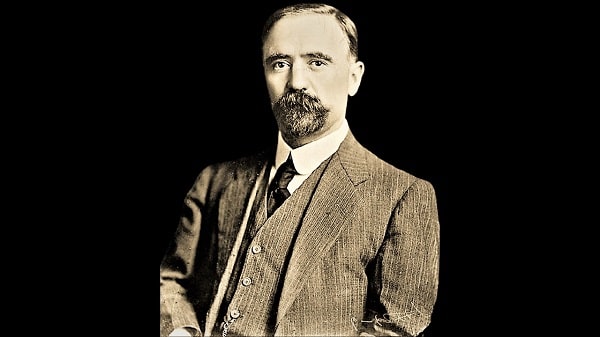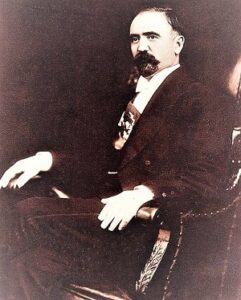
Francisco I. Madero full name Francisco Ignacio Madero González (Born on 30 October 1873 – Died on 22 February 1913) was a Mexican revolutionary, businessman, and the 37th President of Mexico from 1911 until shortly before his assassination in 1913.
A wealthy landowner, he nevertheless became a champion of social justice and democracy. Madero was notable for challenging longtime President Porfirio Díaz to the presidency in 1910 and for being instrumental in triggering the Mexican Revolution.
In 1913, he was betrayed and assassinated along with Vice President José María Pino Suárez, as a result of a military coup (so-called Tragic Ten) sponsored by Victoriano Huerta.

Facts About Francisco I. Madero
- Born: 30 October 1873, Parras de la Fuente, Coahuila, Mexico
- Full name: Francisco Ignacio Madero González
- Profession: Businessman, writer, revolutionary
- In-office: 9 November 1911 – 19 February 1913
- Nationality: Mexican
- Political party: Progressive Constitutionalist Party (previously Anti-Reelectionist Party)
- Residence: Coahuila
- Spouse(s): Sara Pérez, no children
- Father: Francisco Madero Hernández
- Mother: Mercedes González Treviño
- Died: 22 February 1913 (aged 39), Mexico City, Mexico
- Cause of death: Assassination
- Burial: Monument to the Revolution, Mexico City, Mexico
Francisco I. Madero Early Life
Francisco I. Madero was born in the hacienda of El Rosario, in Parras de la Fuente, Coahuila on October 30, 1873, as the elder son of Francisco Madero Hernández and Mercedes González Treviño. The Madero family was one of the richest personal in the Mexico.
He received a careful education with the Jesuits, then went to study in Baltimore, at HEC (international business school) in Paris, after completing his secondary cycle at Lycée Hoche in Versailles and agriculture at the University of California at Berkeley, he also studied banking in Culver Academies in Indiana.
Coming from a family of extremely wealthy entrepreneurs close to the dignitaries of the Porfirio Díaz regime, he wanted to bring democracy to Mexico, but without upsetting the executives of society; he believed that democracy would by itself and over time improve living conditions for all Mexicans.
In 1905 he unsuccessfully presented his candidacy for governor of the state of Coahuila. In January 1909, after overcoming his father’s initial disapproval, he published a book called The Presidential Succession of 1910, which had an unexpected impact.
Its slogan was the same as that of Díaz in its beginnings: effective suffrage and no re-election. Fighting against the government of Porfirio Díaz, who, constantly re-elected, had governed the country since 1876, he created the National Anti-Re-election Party on May 22, 1909, and presented his candidacy in the elections of 1910.
Accused of fomenting an armed insurrection, he was arrested on June 16, 1910, and imprisoned in San Luis Potosí. After escaping from prison, he took refuge in the United States and proclaimed there the San Luis plan that started the Mexican revolution.
The Mexican Revolution
The Mexican Revolution was started in 1910 to end the military dictatorship of President Porfirio Díaz to forced him to exile. After Porfirio Díaz resigned as President on May 25, 1911, after signing the Treaty of Ciudad Juárez, Francisco I. Madero became the country’s highest political leader known as the “Maderism”.
Madero’s followers called him “caudillo de la Revolución” (the leader of the Revolution). He was elected president on October 15, 1911, by almost 90% of the vote. Taking office on November 6, 1911, he became one of Mexico’s youngest presidents just turning 38 years old.
Despite its widespread popularity, Madero’s administration soon encountered opposition from radical revolutionaries and remnants of the old regime. The deaths of Madero and José María Pino Suárez led to a national and international backlash that eventually paved the way for the fall of the Victoriano Huerta Dictatorship, and the victory of the Mexican Revolution.
On 5 February 1917, the establishment of the Mexican Constitution takes place under President Venustiano Carranza.
Presidency (1911- 1913)
After the fall of Ciudad Juárez and the departure in exile of Porfirio Díaz who wanted to prevent a civil war, Madero, then benefiting from the support of the United States, won the presidential election of October 1911, by obtaining 19,977 votes and acceded in power on November 6.
Francisco I. Madero had to face the disillusionment of some of his own supporters but also the opposition of supporters of the old regime, who still held many positions. Coming from the bourgeoisie, he knows little about the living conditions and demands of the popular classes and is above all concerned with restoring the stability of the country.
Emiliano Zapata asks him for agrarian reform, but although understanding towards him, he answers that an agrarian reform cannot be improvised and that the demands of the peasants are too radical. It operates an administrative reform, but it is partial.
Francisco I. Madero also announces a reform of the army that will not however affect the power and influence of the Porfirist generals, Felix Diaz (Diaz’s nephew), who are nevertheless violently hostile to him.
Francisco I. Madero Death
In early 1913, Victoriano Huerta conspired with Bernardo Reyes, Felix Diaz (nephew of Porfirio), and US Ambassador Henry Lane Wilson who feared that the coming to power of Francisco I. Madero should open a period of instability. The coup was set on February 9, 1913.
It was agreed that Madero would be dismissed and that Reyes succeeds him until the elections allow Diaz to power. The coup was the start of a confused and bloody period that lasted ten days. This period is known in Spanish as “Decena Trágica” (the tragic decade).
Francisco I. Madero, who suspected nothing of Huerta’s betrayal, made a series of decisions that were fatal to him. He entrusted Huerta with the command of the troops tasked with subduing the rebels led by Díaz after Reyes’ death. On February 18, Francisco Madero was arrested by General Aureliano Blanquet and imprisoned.
Victoriano Huerta seized power, after convincing Francisco I. Madero to resign and giving him his word that he would be saved. On February 21, Francisco Madero was assassinated along with his vice-presidentJosé María Pino Suárez by soldiers responsible for transferring them from the National Palace to a penitentiary, on the pretext of an attempted escape.
The operation was supervised by General Aureliano Blanquet. Major Francisco Cárdenas, who commanded the detachment, brought down Francisco Madero and shot him twice in the head. The vice president was shot along the wall of the penitentiary.
President Francisco I. Madero, dead at the age of 39, was buried quietly in the Monument to the Revolution, Mexico City, Mexico.
Francisco Madero Quotes
- The Government, …always quenches in blood any democratic manifestation. – Francisco Madero
- A force of tyranny that we Mexicans were not accustomed to suffering after we won our independence oppresses us in such a manner that it has become intolerable. In exchange for that tyranny we have offered peace, but peace full of shame for the Mexican nation. – Francisco Madero
- Peoples, in their constant efforts for the triumph of the ideal of liberty and justice, are forced, at precise historical moments, to make their greatest sacrifices. Our beloved country has reached one of those moments. – Francisco Madero
Real superb info can be found on website.
Really great info can be found on website.